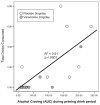Varenicline reduces alcohol self-administration in heavy-drinking smokers
- PMID: 19249750
- PMCID: PMC2863311
- DOI: 10.1016/j.biopsych.2009.01.029
Varenicline reduces alcohol self-administration in heavy-drinking smokers
Abstract
Background: Alcohol and tobacco dependence are highly comorbid disorders, with preclinical evidence suggesting a role for nicotinic acetylcholine receptors (nAChRs) in alcohol consumption. Varenicline, a partial nicotinic agonist with high affinity for the alpha4beta2 nAChR receptor, reduced ethanol intake in rodents. We aimed to test whether varenicline would reduce alcohol consumption and alcohol craving in humans.
Methods: This double-blind, placebo-controlled investigation examined the effect of varenicline (2 mg/day vs. placebo) on alcohol self-administration using an established laboratory paradigm in non-alcohol-dependent heavy drinkers (n = 20) who were daily smokers. Following 7 days of medication pretreatment, participants were first administered a priming dose of alcohol (.3 g/kg) and subjective, and physiologic responses were assessed. A 2-hour alcohol self-administration period followed during which participants could choose to consume up to 8 additional drinks (each .15 g/kg).
Results: Varenicline (.5 +/- SE = .40) significantly reduced the number of drinks consumed compared to placebo (2.60 +/- SE = .93) and increased the likelihood of abstaining from any drinking during the self-administration period. Following the priming drink, varenicline attenuated alcohol craving and reduced subjective reinforcing alcohol effects (high, like, rush, feel good, intoxicated). Adverse events associated with varenicline were minimal and, when combined with alcohol, produced no significant effects on physiologic reactivity, mood, or nausea.
Conclusions: This preliminary investigation demonstrated that varenicline significantly reduced alcohol self-administration and was well tolerated, alone and in combination with alcohol in heavy-drinking smokers. Varenicline should be investigated as a potential treatment for alcohol use disorders.
Figures



References
-
- Li TK. FY 2006 President’s budget request for NIAAA Director’s statement before the House and Senate appropriations subcommittees. NIAAA. 2006. [Accessed February 10, 2008.]. Available at: http://www.niaaa.nih.gov/AboutNIAAA/CongressionalInformation/Testimony/s....
-
- Li TK, Volkow ND, Baler RD, Egli M. The biological bases of nicotine and alcohol co-addiction. Biol Psychiatry. 2007;61:1–3. - PubMed
-
- Grant BF. Age at smoking onset and its association with alcohol consumption and DSM-IV alcohol abuse and dependence: Results from the national longitudinal alcohol epidemiologic survey. J Subst Abuse. 1998;10:59–73. - PubMed
-
- Dani JA, Harris RA. Nicotine addiction and comorbidity with alcohol abuse and mental illness. Nat Neurosci. 2005;8:1465–1470. - PubMed
Publication types
MeSH terms
Substances
Grants and funding
- K02 DA000436/DA/NIDA NIH HHS/United States
- DA00436/DA/NIDA NIH HHS/United States
- 14715/PHS HHS/United States
- P50 DA013334/DA/NIDA NIH HHS/United States
- R01 AA017976/AA/NIAAA NIH HHS/United States
- UL1RR024139/RR/NCRR NIH HHS/United States
- R01 DA014241/DA/NIDA NIH HHS/United States
- R01 AA015596/AA/NIAAA NIH HHS/United States
- 15632/PHS HHS/United States
- K05 AA014715/AA/NIAAA NIH HHS/United States
- P50 AA015632/AA/NIAAA NIH HHS/United States
- UL1 RR024139/RR/NCRR NIH HHS/United States
- 15596/PHS HHS/United States
- T32 AA015496/AA/NIAAA NIH HHS/United States
- R37 DA014241/DA/NIDA NIH HHS/United States
- 15496/PHS HHS/United States
LinkOut - more resources
Full Text Sources
Other Literature Sources
Medical

